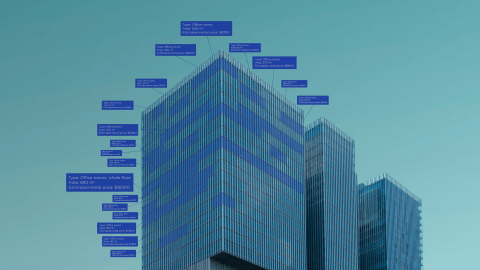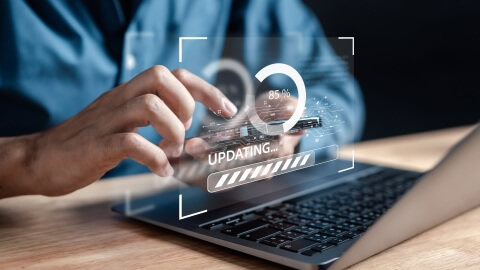Fast-paced AI development leads to more and more innovations in the computer vision field. Object detection and object tracking are among these innovations making people's lives safer and increasing the efficiency of businesses. Object detection and tracking help avoid dangerous situations on the roads, identify traffic signals and vehicles, and many more. There are numerous ways to apply object detection and tracking we'll talk about below.
In this article, our data science software development experts discuss the difference between object detection and object tracking, types of object detection and tracking, the main stages of object detection and tracking algorithm implementation based on our hands-on experience, and the challenges you may face while developing an object detection/tracking algorithm. They also provide useful tips based on the real case of object-detection algorithm development for pig weight monitoring. Don't miss a chance to learn from our experience!
What is object detection?
Object detection is a computer vision technique software engineering applied to identify and locate objects within an image or video. Specifically, object detection draws bounding boxes around the detected objects, locating where they are or how they move through a given scene.
What is object tracking?
Object tracking helps to find an object's location on the footage or in real time. Object tracking algorithms track an object's movement and provide specific data on it.
The process of preparing dataset for object-tracking algorithms includes image labeling (when engineers mark and classify the objects). Its effectiveness can be measured through accurate object ID assignment the algorithm performs.
Object detection & object tracking — what is the difference
Object tracking identifies objects and tracks them during series of frames on the footage or video stream. Object detection is a part of the object tracking process, more specifically, an initial stage when a neural network finds an object on the video or image and identifies it as the target one.
While object detection and object tracking are used to analyze visual data to identify objects' locations, there are key differences between them. Object detection identifies target objects on an image or frame, while object tracking follows a target object's movement across multiple frames. Object detection algorithms typically process each image or frame independently, while object tracking algorithms estimate the target's location in subsequent frames.
Types of object detection
You can create an accurate object-detection algorithm using the two most common methods: machine learning and deep learning. In this part of the article, we will go into detail about those, so keep reading.
ML-based object detection
To make object detection more accurate, data science engineers usually choose machine learning (ML) models. The main idea of the ML approach is training a model on labeled images with the examples of the required objects. Once it's trained, you can use it to process new images, detecting objects on them.
One of the ML techniques is aggregate channel features (ACF) that enables target object recognition (taken from a training dataset). Another common ML technique is the deformable parts model (DPM) that recognizes objects by identifying object's parts and analyzing their interconnection.
Deep learning
Deep learning training methods for object detection add more accuracy to algorithm's outputs. You can create a custom algorithm and train it manually or opt for a ready-made neural network. For deep learning object detection, you will need to train convolutional neural networks (CNNs). They provide faster and more precise results. However, note that you will need a powerful graphics processing unit (GPU) as well as a much larger training dataset than that usually required for mathematical modeling.
Types of object tracking
The variety of fields where object tracking can be used quickly increases, and engineers find more and more solutions to train neural networks to track target objects for different use cases. Below, we will discuss the most common types of visual object tracking such as image and video object tracking.
Image tracking
Image tracking is used for locating target objects within the variety of other objects or spot needed changes in the target objects. This way users can allocate tracking of target object modifications on multiple images and provide valuable outcome. For example, image tracking helps medical professionals analyze tumor growth.
Video tracking
When tracking objects in videos, a neural network must process a set of images sequentially. To track a moving object, engineers need to train a neural network to predict an approximate direction in which the target object will move. The algorithm estimates the past and current location of an object on the video frames and tracks it down as long as it is visible. Thus, such an object-tracking algorithm can meet your requirements if you need to develop an app for tracking traffic on the roads or create a solution for security monitoring.
As you can see, object-tracking algorithms can be used for image and video tracking, which expands the ways you can apply AI to your solution. Find out how we created an object-tracking algorithm for measuring a horse's level of stress.
Levels of object detection
The same as object tracking, object detection can be applied in various fields, requiring different levels, which depend on the complexity of the tasks. Here are the three levels of object detection you may need for your solution.
Bounding Box Detection
This level revolves around detecting objects and their locations by enclosing them with bounding boxes (rectangular forms). Bounding box detection informs about the object's location without any details about the object's shape or structure.
Semantic Segmentation
Semantic segmentation assigns a semantic label to each pixel on the image. On this level, the object detection algorithm classifies each pixel into different object classes, ensuring more precise object localization and providing information about the target object’s shape and structure.
Instance Segmentation
Instance segmentation differentiates between individual instances of the same object class. It assigns semantic labels to pixels and a unique ID to each object instance. Instance segmentation works with lookalike objects and assigns instances of each object from different classes.
You can choose the level of object detection depending on the complexity of your requirements to the algorithm, with instance segmentation being the most suitable for challenging projects with multiple objects and bounding box being useful for simpler tasks.
Levels of object tracking
Depending on the task you need a neural network to perform and the number of objects to track, our data science experts will use different approaches to training. Object tracking levels include single object tracking (SOT) and multiple object tracking (MOT), which we will discuss below.
Single Object Tracking (SOT)
SOT focuses on tracking a single object in a video footage or stream. SOT algorithms typically rely on the initial location of the object, which is defined manually or automatically. After that, the algorithm estimates the object's motion and extracts its features to track its movement over time. SOT algorithms are applicable in different domains, including AR, surveillance, and autonomous vehicle management.
Multiple Object Tracking (MOT)
MOT algorithms track multiple objects simultaneously in video or real-time data streams. MOT algorithms are challenging to develop since they need to track objects of different sizes and appearances, moving in different trajectories. For MOT, data science engineers use data association, trajectory prediction, and motion modeling techniques. MOT is widely used for human activity analysis, traffic monitoring, and crowd management.
Depending on the level of an object-tracking algorithm you need to develop, the structure of the neural network will vary. The MOT algorithm with a more complex structure will require a bigger dataset and more time for training. Besides, data science experts need to label all the objects on each dataset image. SOT is a simpler level that requires labeling one object on each dataset image.
6 main applications of object detection and object-tracking algorithms
Object detection and tracking are mostly used in medical, military, automotive, and security fields. Read the most widely used applications of object detection and tracking algorithms.
Smart parking management
To alleviate the burden of the drivers in search of a free parking spot, parking lots owners started using object-detection algorithms to track how many free parking spots are available. Besides, smart parking systems are integrated almost in every modern car and help drivers park safely, informing drivers about obstacles.
Automatic payment in grocery stores
Object detection and tracking can reduce lines in grocery stores. Customers don't need to pay by cash or by card. In such stores, a customer has an app with specific identification that allows them to simply take the products they need and walk out of the store. A computer vision system will scan what products the customer takes and charge them through a payment system in the app.
Human behavior analysis
Improved safety is also the achievement of object detection and tracking algorithms. Surveillance cameras with AI can track offenders and register any types of criminal behavior. If needed, a police department can use the footage and find a person that has violated the law.
Warehouse management
With the help of object detection and object-tracking algorithms, businesses can effortlessly track package movement within a warehouse. AI technologies enable identifying package's state and storage conditions as well as scanning label information, acting as an object tracker. Since an object detection or tracking system can recognize each package, the chance that a product will be lost becomes significantly lower.
Biometrics and facial recognition
Security systems in airports run on object detection and tracking algorithms as well. To verify the identity of the travelers, a computer vision solution compares a passenger's face with the picture in the passport to avoid fraud. The system also checks whether a passenger's behavior is not suspicious.
Artificial reality
One of the trending ways to use object detection revolves around the augmented reality (AR) sphere. For instance, users can download an app for virtual clothes fitting. The algorithm in the app is trained to detect a person on the image, and once a user is detected, the algorithm puts on a garment over a user. Another example of object detection in AR includes the apps for smart home and furniture industries. Users can take a picture of their apartment or house and check what a specific smart home device or piece of furniture will look like in their setting.
As you can see, object detection and tracking have many applications, and there are no limitations to specific industries. If you need a state-of-the-art solution with an integrated computer vision system, don't hesitate to discover your opportunities with us.
7 stages of object detection and tracking implementation process [Real case]
Here, we will share the practical experience of our data science engineers who developed an object detection algorithm for an embedded vision prototype that measures pigs' weight in real time.
Our client is an agricultural company that grows pigs and cattle and sells self-produced food products. They weigh pigs regularly to monitor their health and feeding flow. Before the object detection solution implementation, our client needed to weigh pigs manually, which was a labor-intensive and time-consuming process. That’s why the Lemberg Solutions team was asked to automate this process.
Our data science experts move through the following stages to create an ML model:
- Defining dataset requirements.
To save you time and costs, our engineers analyze the requirements to the future algorithm. This helps to collect the relevant data and consider how to get a proper dataset proper on the first iteration.
- Collecting a dataset.
After identifying the requirements, our data science team collects the required number of images/videos. We always care about the quality of the collected data since it affects the accuracy of the designed algorithm. For this case, we captured images of numerous pigs of a specific breed on our client's farm to make the dataset big enough.
- Data labeling.
The dataset is ready, you have the images of the highest quality and diversity, what's next? Now, we label the data to train the neural network. For instance, if your target objects are vehicles, you must label them on the images or videos you've added to your dataset. Our data science team labeled pigs since dataset labels are required for supervised training.
- Choosing the most suitable ML model.
Our data science engineers analyze the available ML models that have already been trained to save time on re-training a model. If no ML models suit the client's requirements, we train it from scratch on the collected dataset (which is the most frequent option).
- Undertaking several training iterations.
Our experts train the neural network, check the results, gain some feedback on its accuracy, implement the needed changes, and start the next training iteration. Neural networks rarely have high accuracy after the first training, so it takes time to achieve a good result.
- Field testing.
If a project requires testing a solution in the field, our data scientists visit the client. To check the performance of our weight-measuring algorithm, we went on a farm and examined how the solution behaved in real-life conditions.
- Integrating an ML model into a target device.
Our engineers incorporate an algorithm into an embedded device/mobile phone or upload it to the server. For this project, we integrated the algorithm into a portable handheld device.
We follow these stages for each data science project that requires object detection. The workflow for object-tracking algorithm development has similar stages. The key difference is the approach to data collection, processes, and algorithm creation.
4 core object detection and tracking challenges & difficulties with solutions
Despite significant advancements in object detection and tracking technologies, several challenges and difficulties persist. Some of the key challenges engineers usually face in object detection and tracking include:
Components and video streaming specifics
While tracking a moving object, an algorithm must see it distinctively to identify the target object and its characteristics properly. The higher the speed, the more blurred the object appears. Note that a camera doesn't instantly shoot a frame with an object; it accumulates light on a sensor to make a frame. If the duration of the frame is long enough, the final image will be properly lit, but the object may come out blurred. If the duration of the frame is short, the target object will be less blurred, but the final image will be dimmed. Data science engineers strive to find the middle ground. As an option, our team turns to image post-processing, finds blurred frames, and decides whether the frames are good enough for further analysis.
For example, for our object-detection algorithm for pig weighing, we analyzed the level of blurriness and trained the neural network to identify the frame that is sharp enough to not impede the accuracy of results. Besides, detection speed highly depends on the hardware components you choose. Our team can help you select the right components for your embedded AI solution.
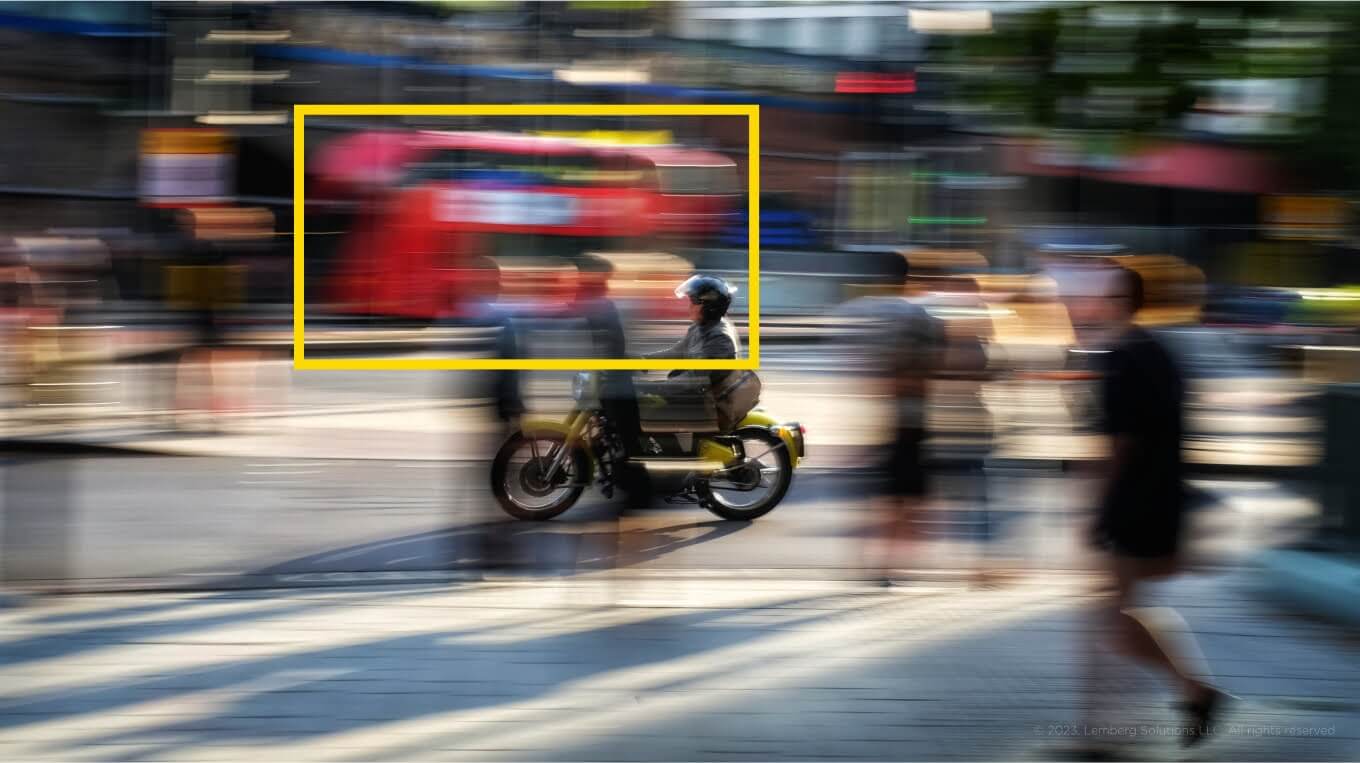
Different object sizes
Target objects can vary significantly in size, which makes object detection and tracking challenging. Moreover, the algorithm needs to accurately detect and track them even when the objects move towards or away from the camera, which causes changes in their real size.
For our object-detection algorithm, we created a solid solution that works well with different sizes of pigs. However, we faced several problems that harmed the accuracy of the algorithm at the first training iterations. The height of the camera and the shooting angle influence the accuracy of measuring pigs' size. We noticed that the most suitable solution is to put a pig in the center of the frame since other angles may dim certain parts of a pig.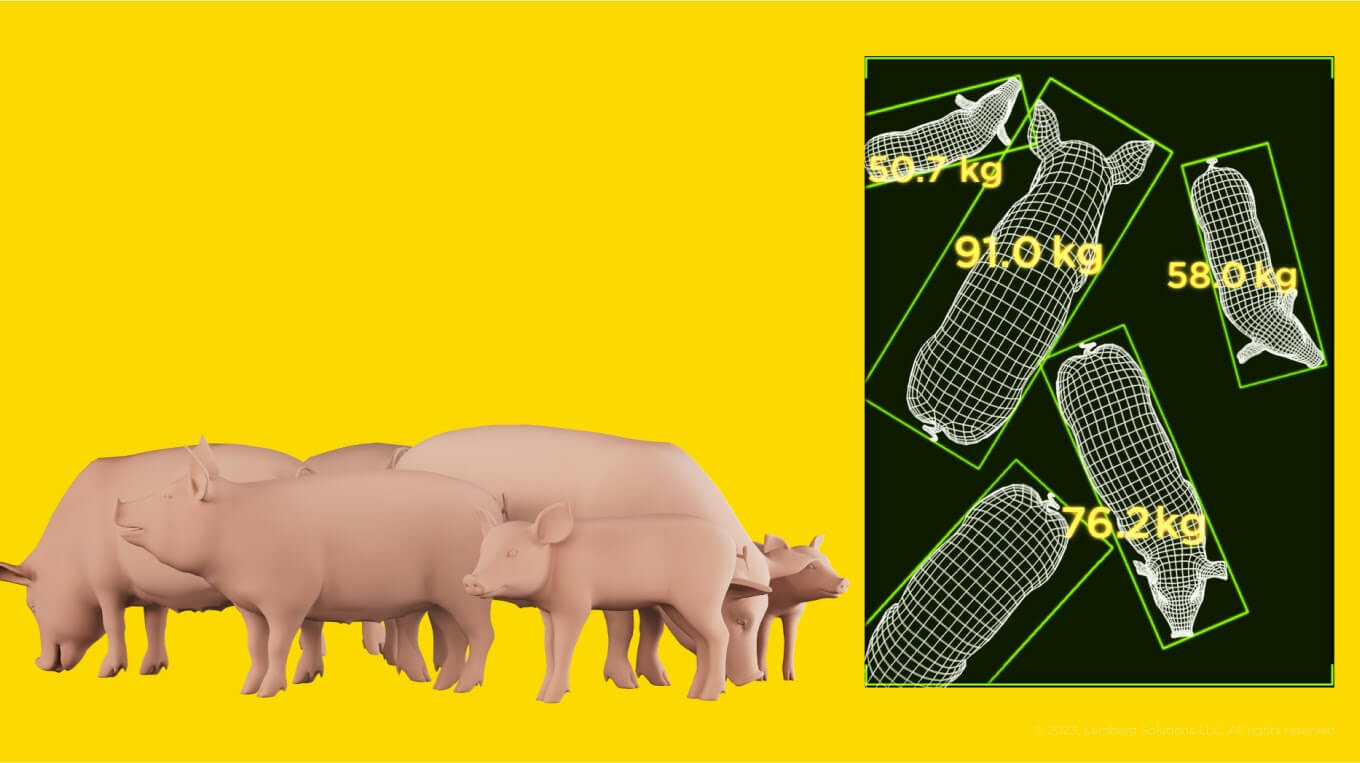
Occlusion
Occlusion happens when other objects or the background partially or completely obscures a target object. That’s when the object detection or tracking algorithm may lose a target object, resulting in an inaccurate output. To handle occlusion, engineers need to develop a complex algorithm that can accurately detect or track objects even when they are partially hidden.
We dealt with occlusion while developing our algorithm for pig weighing since the solution had problems capturing a pig if it was too close to other pigs. The breed of the pigs influenced the detection accuracy as well. That's why we trained our neural network using the same pig breed since they weren’t dramatically different. As a result, our algorithm effectively overcomes occlusion and provides correct results.

Background clutter
The target objects for detection and tracking are often located in complex environments with cluttered backgrounds. Background clutter adds redundant information or noise that can confuse the object detection or tracking algorithm and lead to inaccurate results. Dealing with background clutter requires effective feature extraction and noise reduction techniques to ensure accurate object detection/tracking.
We recommend training a neural network to detect and track target objects within different backgrounds. Our data science engineers train the neural network using various images with multiple backgrounds to make the algorithm more precise.
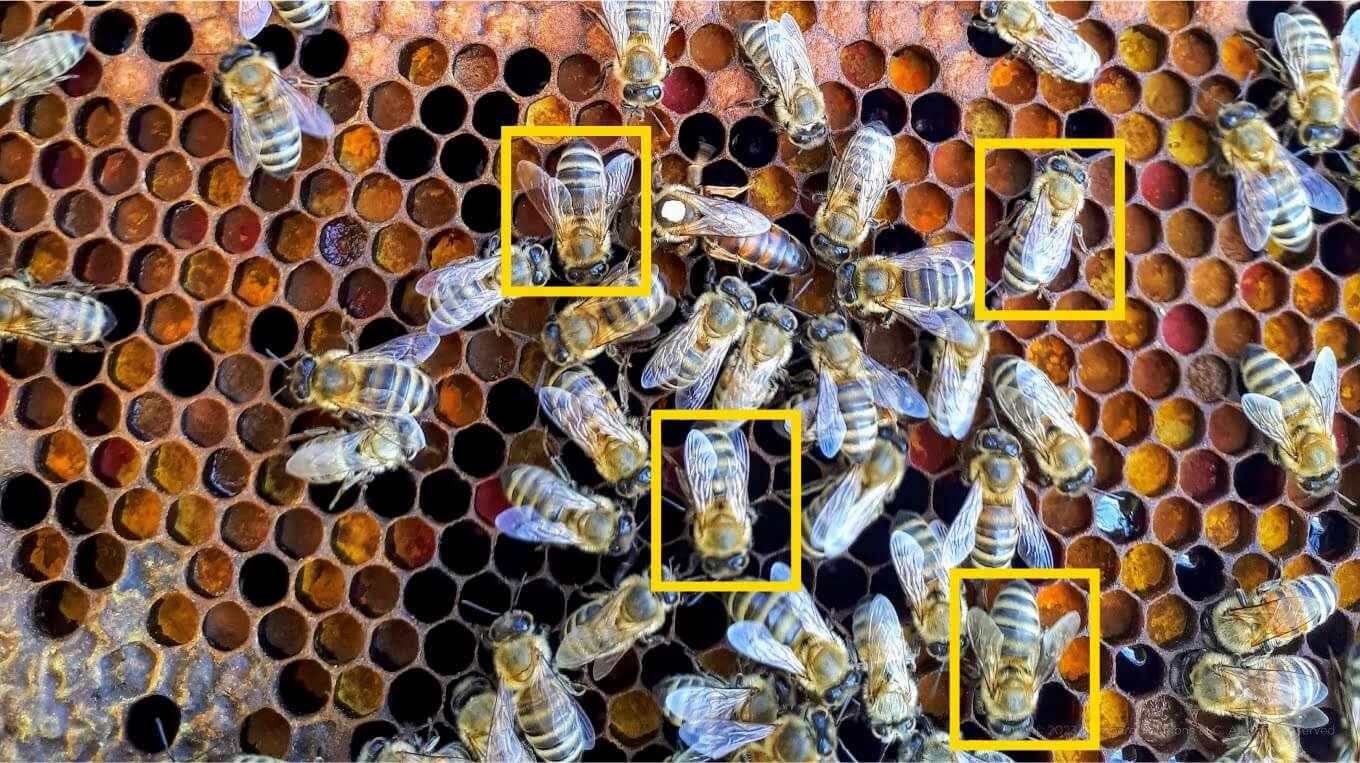
To make your neural network better trained, collect a large dataset and shoot target objects within different backgrounds and lighting to increase the dataset diversity. You should consider numerous factors to detect and track moving objects accurately — the algorithm must be able to work in a broad range.
Object detection and tracking tech stack to use
Ready-made object detection and tracking algorithms are essential for data science engineers working with computer vision since they are useful in a wide range of applications, such as surveillance, autonomous driving, and robotics. The most popular algorithms for object detection and tracking are DeepSort, Optical Flow, and YOLO. Read below and learn more about these algorithms and how we use them for computer vision projects.
DeepSort
DeepSort is an object detection and tracking algorithm that uses deep learning to track objects in real time. With simple online and real-time tracking (SORT) algorithm at its core, DeepSort estimates the position, velocity, and size of target objects using a deep neural network to detect the objects, identify their existing tracks, and estimate their trajectories accurately.
Optical Flow
Another algorithm suitable for object detection and tracking, Optical flow, is provided by the OpenCV computer vision library and uses computer vision tools to estimate the motion of target objects in a scene. Optical flow analyzes the changes in the pixel intensity in a video frame and calculates the direction and scale of the motion. Optical flow is useful for dynamic motion in the video footage or stream or when the target objects move erratically.
YOLO (You Only Look Once)
YOLO is an object detection and tracking system that uses deep learning to identify objects in an image or video stream. YOLO breaks the input image down into pixels and predicts the probability of an object's presence in each pixel. YOLO is known for its speed and accuracy and is widely used in real-time applications such as surveillance and self-driving cars. YOLO is frequently used as an object detection foundation for the following object-tracking algorithm development.
Data science engineers need to choose the appropriate algorithm for the project. After the algorithm is trained, it can be applied to real-life scenarios. For a pig weighing solution, we used DeepSort and Optical flow, which made up the basis of our algorithm. However, the image processing pipeline consists of many custom algorithms since our client needed a unique data science solution.
Final thoughts
Tracking the objects in real-time with object detection and tracking algorithms spreads over an increasing number of fields. Data science engineers come up with various solutions to train neural networks to detect and track target objects with utmost accuracy.
Understanding the challenges associated with developing object detection and tracking algorithms, such as tracking speed, different object sizes, occlusion, and background clutter, is crucial for developing robust and effective object detection and tracking solutions. Overcoming these challenges will enable the development of advanced object detection and tracking algorithms that can operate in real-time and deliver accurate results in complex real-life conditions.
DeepSort and Optical Flow, two popular algorithms, together with YOLO, a neural network, are used to simplify object detection and tracking development. Data science engineers choose the best-fitting algorithm for the project, collect and label a dataset, train the neural network, and integrate the algorithm into a device.
At Lemberg Solutions, we have the expertise to develop object detection and tracking algorithms that can be incorporated into your embedded solution. Our data science engineers enable our clients to automate multiple processes to save time and resources. Contact us and learn more about our computer vision services and object detection/tracking development.
FAQs
Whas is object tracking?
Object tracking follows a target object's movement across multiple frames in a video sequence. The objective of object tracking is to maintain the identity and trajectory of an object over time. The target object is manually or automatically selected in the first frame, while subsequent frames are analyzed to estimate the target's location.
What is object detection?
Object detection identifies and localizes objects within an image or a video frame. Object detection algorithms determine the presence of target objects and detect single or multiple objects in an image simultaneously, identifying each object's location and class label.
What is the difference between object detection and object tracking?
Object detection and tracking identify target objects on the image or video frame. However, object detection works with separate images and frames, while object tracking analyzes target object's location in multiple frames to be able to track it.
When to use object detection and object-tracking algorithms?
Object detection is usefed when you need to determine the presence and location of target objects in a static or dynamic scene. For instance, recognition and localization of objects on images or videos for image retrieval, image captioning, and visual search. Object tracking is used to follow and monitor the movement of a specific object across subsequent frames of a video sequence. It can be useful for tracking specific cars to recognize road traffic violations.



